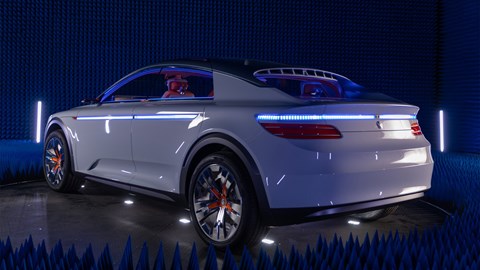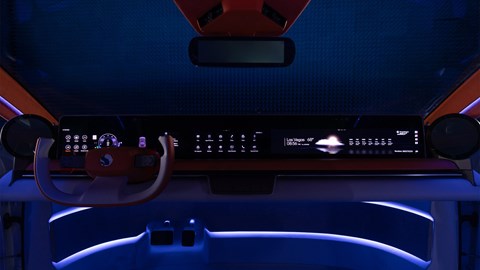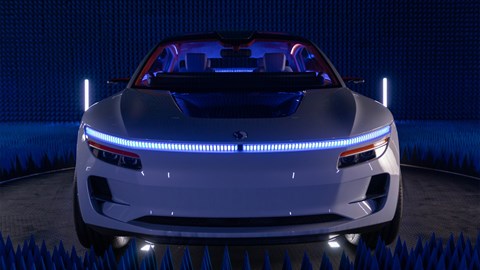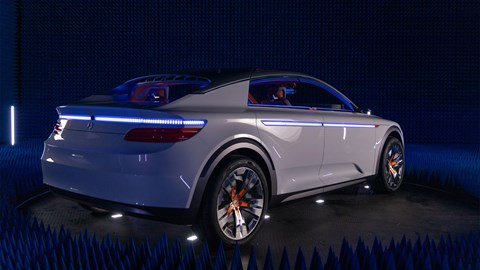► Powered by Qualcomm’s Snapdragon Digital Chassis
► Features artificial intelligence, facial recognition…
► … and a huge 55-inch infotainment screen
Technology firm Qualcomm unveiled a new concept car at the 2023 Consumer Electronics Show to showcase its latest suite of in-car technology. Qualcomm is one of the many tech companies entering the automotive space, joining the likes of Sony and Apple – and it hopes to increase the level of personalisation and connectivity in future cars through its expertise.
Qualcomm hasn’t given its concept car a name, nor has it confirmed whether it’ll enter production. However, we expect it’s just a means for the brand to show off its technology.
Qualcomm’s Digital Chassis technology suite can recognise each driver and automatically adjust the seat position and climate controls to their preference. The infotainment screen will also display that driver’s recently used applications.

We’ve seen similar tech from traditional car brands – but Qualcomm goes a step further. Using a facial recognition camera from Wink and biometric authentication, drivers will be able to make purchases from their car, be they for media used inside the vehicle (such as music) or services outside the vehicle (like parking).
The concept also previews a swanky audio system, which Qualcomm says will allow each passenger to play different music. The cabin is separated into ‘audio-zones’ – and noise cancelling technology will prevent neighbouring occupants from hearing each other’s music.
Qualcomm is shunning touch inputs, too. The firm has developed a new natural voice recognition system which will allow drivers to interact with every system on the car, whether it’s adjusting the seat position, making a purchase or turning up the music volume. Every occupant in the car will also have their own virtual assistant for their specific audio-zone.

Despite the move away from touch inputs, the concept still features an enormous 55-inch pillar-to-pillar display for the front passengers that displays information such as navigation instructions, vehicle speed, media, weather and driver assistance technology data.
Sounds like you’ll need a powerful processor to run that lot
Qualcomm has that covered. The concept also showcases the company’s new Ride Flex system-on-a-chip (SoC), which is a central computing solution that’s powerful and adaptable enough to run a range of electrical components in the vehicle, vastly reducing complexity in the process.
So, instead of having hundreds of ECUs to control a car’s various electrical systems, Qualcomm’s setup will allow for a handful of powerful processors to control clusters of components, such as all the interior functions and the complete ADAS system. Qualcomm’s system is also linked to the cloud by 5G and supports car-to-car connectivity.

The point of this technology is get cars ready for the autonomous revolution. Qualcomm’s Ride Flex system can run up to Level 4 self-driving vehicles – and it won’t be too long before that technology hits the open market, especially now that Mercedes has been given the green light for its Level 3-capable self-driving system for the S-Class and EQS saloons.
Anything else worth mentioning?
Qualcomm says it’s building the technological basis for a software-defined vehicle, which will soon become the norm if automotive development keeps heading in the same direction. The company describes a software-defined vehicle as: ‘a vehicle wherein the features are enabled by agile delivery of software over the lifetime of the vehicle extending beyond point of sale.’
This is one of the more controversial elements of Qualcomm’s concept. Yes, it allows manufacturers to continuously improve their cars once they leave the showroom. For example, this means brands can sell cars with all the necessary hardware for self-driving but release software allowing greater autonomous capability as legislation changes and allows drivers to take more of a back-seat role.

However, it also allows manufacturers to add extra software to a vehicle later to generate additional income. BMW launched a similar system for the heated seats and heated steering wheels on its cars mid-way through 2022, locking both behind software-driven subscription services – and the move received significant backlash from consumers.
UBS, the multinational investment bank, expects the market for software-as-a-service in the automotive sector to be around $700 billion (roughly £582 billion) by 2030. As such, a lot of car companies have been transforming into technology companies over the past five years – but Qualcomm hopes to capitalise on its background and offer manufacturers an off-the-shelf solution to help trim down their development costs and increase its own profitability.
